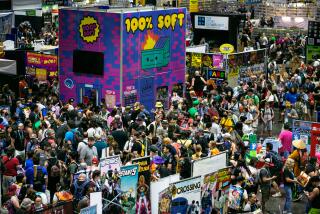‘84 olympics Pins
- Share via
Edwin Moses may have hurdled his way into the record books, and Mary Lou Retton may have wowed them with unparalleled feats on the bars, but the real action at the 1984 Olympics was over at the six-pack-shaped Budweiser pin-trading tent across the street from the Coliseum.
Hundreds of collectors from L.A. and beyond lined up in front of the inflatable trading center for hours, day and night, pinning their hopes on buying or trading up for a Coca-Cola Sam Eagle, worth $700 at the peak of the frenzy, or a Welcome LA ‘84, an Olympic favorite, for about $150.
“We were warned it was dangerous by the Coliseum, but it was totally safe,” recalled Huntington Beach pin-trader Margarita Volker. “There were police everywhere.” And what were they doing? “They hung around and traded with other officers.” Commemorative pins made for various branches of law enforcement were especially coveted. The 150 or so FBI pins were so sought after that they commanded $200, and Interpol and SWAT pins generated heat, too. “I wanted to trade a pin with a guy who turned out to be Secret Service,” Volker recalls. “He said he couldn’t do it.”
Any gas station, dormitory entrance or McDonald’s close to an Olympics venue drew hordes of exhausted traders, who gathered at day’s end to show off their latest acquisition or lament the one that got away. “There was anxiety--we had to get the hottest, best pins,” Volker recalls. “It didn’t always happen.” Talk about the agony of defeat.
San Diego physician Doug Todd, a UCLA student at the time, says Los Angeles was magical during the ’84 Games. “The sky was clear, people had left town, it wasn’t crowded. The economy was good then, people had money to spend, so they traded pins.” Ed Biegel, a retired Los Angeles garment salesman who haunted the pin-trading tent while Bart Connor captured two gold medals in gymnastics just a freeway away at UCLA, agrees. “There will never be another ’84 Olympics.”
More to Read
Go beyond the scoreboard
Get the latest on L.A.'s teams in the daily Sports Report newsletter.
You may occasionally receive promotional content from the Los Angeles Times.






